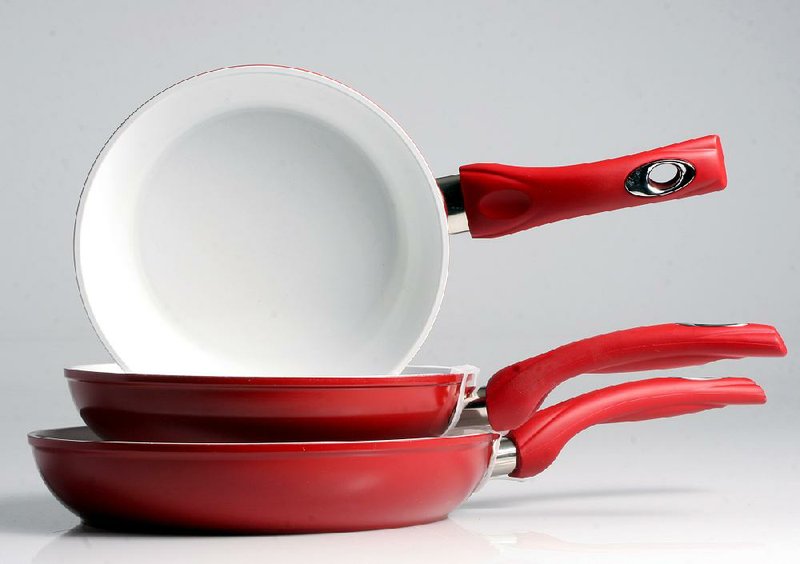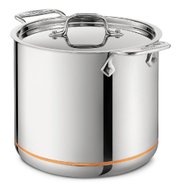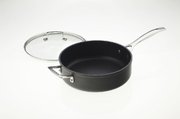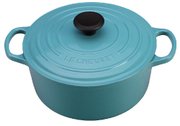Picking the perfect pan for cooking may seem simple enough. A frying pan for scrambled eggs and burgers. A huge pot for boiling pasta or sweet corn.
If you want to cook well, though, choosing the right pan for a particular technique or recipe can mean the difference between culinary success and lousy results. A seasoned cook knows this.
Others cooks? Not so much, suggests Aida Mollenkamp.
"They might think they're not a good cook or a recipe doesn't work when in fact they just aren't using the right tools. ... So you'll have one person using a frying pan and trying to braise in it and that is generally not going to work very well," says Mollenkamp, whose cookbook Keys to the Kitchen (Chronicle Books, $35) details pan shapes and materials and how they can affect what you're cooking.
"Look at the main thing that's happening in a recipe, then decide on the pan," she says.
Of course, things can get confusing. For instance, chefs and pan-makers have several names for wide shallow cooking pans -- those you may call skillets or frying pans -- but chef Christopher Koetke, host of Let's Dish on the Live Well network, can clear that up.
There are basically two types -- "saute pans with straight sides and saute pans with sloped sides," says Koetke, who is also vice president of Kendall College School of Culinary Arts in Chicago. "The one with the sloped sides is technically called a sauteuse. ... And what we refer to as a saute pan here [in the United States] -- the sautoir -- is the one with the straight sides."
But you won't need dozens of pots and pans to be a good cook -- just good pans. "It's better to start with a few pieces and add to it than buy a set of stuff that's really substandard," Koetke says.
Mollenkamp adds: "There are three things you need to be willing to invest in for the kitchen. Knives, a good cutting board and a good pan. If you don't have those things then you're really going to be in an uphill battle."
So what pan should we be using for which cooking technique? Here are Koetke's and Mollenkamp's suggestions based on five types.
Slope-sided skillet
For: pancakes, vegetables, eggs, crepes, delicate foods. "It's really good for flipping things," Koetke says. Or redistributing vegetables while they're cooking. And if you need to get under food to turn it, "your spatula sort of follows the contour of the pan."
Straight-sided skillet
For: pan-frying steak, chicken, pork; searing; deglazing cooking liquids for a pan sauce. "If you're going to cook in a half-inch of oil, you definitely want the straight-sided pan," Koetke says. Why? Cooking oil won't slosh out the sides, nor will spatters from pan-frying meats. Also, he adds, it's easier to reduce liquids for a pan sauce -- in a sloped pan, when liquids bubble up they may burn on its sides.
Stockpot
Tall, narrow pot with two handles. For: pasta, gnocchi, dumplings, stock/soups, blanching. "You want that higher pot so the food can drop in and bounce back up as opposed to trying to do that in a Dutch oven," Mollenkamp says.
Dutch oven
Large round or oval, wider than it is tall, two handles, tight-fitting lid, stove top and oven safe. For: braises, pot roasts, stews, slow simmers on the stove or in the oven. "Anything that's going to cook low and slow, you've got to have a Dutch oven," Koetke says.
Mollenkamp adds: "Because it can hold in the heat, you're not going to have to worry about your sauce burning along the way. ... It really can be one-pot cooking that you wouldn't get if you use a lightweight sauce pot."
Saucepan
Round, single handle, heavy bottom. For: milk, custards, puddings, sauces, melding flavors while retaining moisture. "If you're interested in making a pate a choux or any of those pastries that need to really be worked in the pan, with a saucepan like that you can maneuver with it," Mollenkamp says.
WHAT TO LOOK FOR ON LABELS
"You don't need many pots and pans, but you do need good ones," writes Mollenkamp in Keys to the Kitchen. Choose pans that are ovensafe, she suggests, noting "very few nonstick pans can withstand high oven temperatures." Here are several materials she cites in her book:
Aluminum: "Economical and lightweight," but "does react with some ingredients."
Anodized aluminum: Treated to be "almost nonstick," but "costlier than regular aluminum."
Cast iron: "Holds heat like no other" but quite heavy and acidic ingredients "may take on a metallic flavor."
Copper: Good conductor but should be lined, usually with stainless steel because "copper reacts with a lot of ingredients."
Enamelware: Cast iron or steel that's coated with enamel; must be cleaned with nonabrasive utensils so enamel doesn't scratch or chip.
Stainless steel: Nonreactive and durable but "doesn't conduct heat as well as other metals."
Clad: Different metals paired for best properties of each; manufacturers sandwich good conductors (i.e. aluminum or copper) with stainless steel.
Nonstick: Choose nontoxic coatings, but don't expect exceptional browning.
HOW TO SHOP FOR PANS
Dozens of pots and pans of varied sizes, types, materials and colors reside in cookware stores, some bearing imprimaturs of food personalities (i.e. chef Thomas Keller, Rachael Ray and Guy Fieri). We asked Koetke what to look for when shopping:
"Is there heft to the pan? If it's light and flimsy, then the metal is thin and the thinner the metal, the greater there is a possibility of hot spots and/or warping over time."
Will you be able to lift it when it's filled with food?
Are the pan and handles oven safe? They should be.
Is the handle comfortable to hold? Bolted to the pan? Or welded? "Look at the way it's attached to the pan. Sometimes you have these little spot welds that hold the pan together. Over time, those will break."
Does it have a thick bottom base? "Sometimes people put heavy plates on the bottom of the pan and then the rest of it is thin metal. I'm not a gigantic fan of that because it tends to burn on the side of the pan where the metal stops."
Choose pan sizes depending on your family's size. You can always go back and supplement with pans as your family grows or cooking style changes.
Food on 09/23/2015



